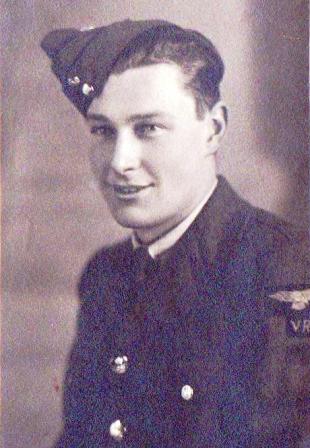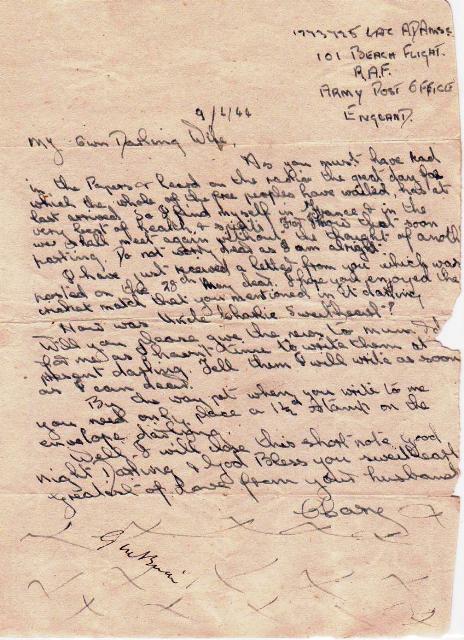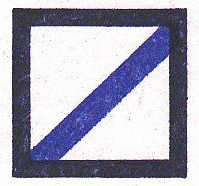Clary Adams and the MT Section of 101 Beach Flight
Clarence George Larter Adams was a sheet metal worker / silversmith and broke his apprenticeship to join the R.A.F. after war broke out. He was twenty years old when he enlisted in the R.A.F. Volunteer Reserve, on 28th December 1940.
Following basic training, Clarence (known as Clary) attended No. 8 School of Technical Training at R.A.F. Weeton, near Blackpool, becoming an Aircraftman First Class on 29th September 1941 and then joining No. 13 Maintenance Unit (based at R.A.F. Henley). His trade in the R.A.F. was Coppersmith and Sheet Metal Worker.
On 1st February 1942, whilst with No.13 M.U., Clary qualified as a Leading Aircraftman (LAC). He was transferred for a while, from June 1942, to R.A.F. Eglinton (situated near Lough Foyle in Northern Ireland) and, back home in Dorking, Surrey in November 1942, he married Lilian King

LAC Adams joined a new R.A.F. Beach Unit on its formation in May 1943. No. 70 R.A.F. Beach Unit formed at R.A.F. West Kirby and immediately moved to Ayr, in Scotland.1
As a Coppersmith and Sheet Metal Worker (C & S M Worker) LAC Adams was in the Mechanical Transport Light Repair section of his unit (referred to as the M.T. Section). The purpose of the M.T. Section in a beach unit was to help with R.A.F. vehicles that came to grief coming ashore from landing vessels. Drowned, broken down or damaged vehicles were taken to a Drowned Vehicle Park by the Army’s Beach Recovery Unit and the M.T. Section did what they could to get them back in action. The M.T. Section was actually the biggest section in an R.A.F. beach unit, consisting of one officer and 18 other ranks. The trades represented in the M.T. Section were as follows: six M.T. Fitters (including corporals and senior N.C.O.s), four M.T. Mechanics, two Electricians, one Carpenter, one C & S M Worker, one Blacksmith & Welder, one Aircrafthand General Duties and two Drivers M.T.
When No. 70 Beach Unit took part in Exercise “JANTZEN” in southern Wales beginning in late July 1943, the M.T. Section had little to do as no difficulties were experienced with the landing of R.A.F. vehicles. However, when volunteers were called for to work on ships and landing barges (L.B.V’s) due to a shortage of available Docks Operating personnel, the whole M.T. Section volunteered and did very good work, helping with the checking and unloading of R.A.F. stores.
In September 1943, Clary’s section had become the M.T. sub-section of No. 101 Beach Section and spent some time training at No. 6 M.T. Unit at Glasgow.
At the beginning of November, Clarence went with the rest of his Unit, on attachment to the R.A.F. Regiment at Grantham for a two week Battle Course which was part of the training R.A.F. beach unit personnel received to prepare them for an assault landing operation.
Clary was at No. 6 M.T. Unit at Glasgow from 24th November to 13th December 1943. On his return from that attachment, No. 101 Beach Section took part in Exercise “ROUNDABOUT I” at Gullane but the M.T. sub-section was withdrawn from the exercise on 24th December so that they could go to No. 8 School of Technical Training at R.A.F. Weeton for a 21 day course on diesel engines. By the time the course was over Clary’s unit had re-located to the Moray area, near Inverness.
At the beginning of February 1944, Clary’s Beach Unit became part of 2nd Tactical Air Force and on 9th February Clary, with the rest of his M.T. section colleagues, was attached to No. 70 Mechanical Transport Light Repair Unit (70 M.T.L.R.U.) at Croydon for more training.
In due course Clary moved with his unit to the South of England. In May, when the order came to waterproof the vehicles, Clary’s section had to work from early morning until dark until the task was completed. Eventually they embarked for Operation “OVERLORD”. We don’t know the exact circumstances of Clary’s landing in the SWORD Assault Area (the M.T. Section arrived in small groups at different times) and his experiences during those weeks in Normandy can only be imagined with the help of available records.
On D+3, 9th June 1944, Clary wrote a letter to his wife, Lilian at home in Dorking, Surrey. He began:
“As you must have read in the Papers or heard on the radio the great day for which the whole of the free peoples have waited, has at last arrived. So I find myself in France & in the very best of health & spirits. For I know that soon we shall meet again without the thought of another parting. Do not worry dear as I am alright.”
There was no mention in that reassuring and loving letter, of the enemy air raids or the shelling and mortaring of the beaches that took place that day. In fact the shelling and the air raids were daily events in the SWORD area throughout June and July.
Clary Adams’ letter, pictured right, also bears the signature of F/Lt G. McBride, acting as censor.

Though he may not have spoken about it, we do know something about the contribution made by LAC Adams and his comrades in the M.T. Section. As hardly any R.A.F. vehicles were landed over the SWORD beaches, the M.T. Sections of Nos. 101 and 102 R.A.F. Beach Flights spent most of their time helping the Army.
On 1st July 1944 the 101 Beach Sub Area R.A.S.C. Commander, Lt. Col. H.E. Hopcroft wrote, about the attachment of the R.A.F. Beach Flight M.T. Sections to the Army’s General Transport Companies workshops.2
Lt. Col. Hopcroft said that, “Very able and willing assistance was given at all times by the R.A.F. personnel.”
Clary’s section, consisting of F/Lt F. Baker and 17 other ranks were attached to No. 101 Company R.A.S.C. (Gen. Tpt.) and Lt. Col. Hopcroft wrote, “The high standard of workmanship and assistance given undoubtedly helped to maintain the DUKWs in a seaworthy condition at a very critical stage of the operation.”
F/Lt J. Pinder and the 18 other ranks of No. 102 R.A.F. Beach Flight‘s M.T. Section were attached to No. 39 Company R.A.S.C. (Gen. Tpt.).
“This enthusiasm and skill in co-operating with the R.A.S.C. workshops personnel was such that no vehicle was V.O.R. for 48 hours unless it was a complete ‘Z’ Casualty.” Additionally, F/Lt Pinder “carried on the control and organisation of the Workshops” when the R.A.S.C. Workshops Officer, Captain Davies was killed by enemy action on 12th June.
On 13th July 1944, when the beach work had slackened off (in fact, the SWORD beaches had been closed), Clary, along with the rest of 101 Beach Flight‘s M.T. Section was attached to No. 70 M.T.L.R.U. which had arrived in Normandy and was located at Cully.
Following the disbandment of No. 1 R.A.F. Beach Squadron in August 1944, LAC Clary Adams returned to the UK where he remained for the rest of his R.A.F. service, which included seven months with Bomber Command’s 43 Base in the East Riding of Yorkshire.
This account appears with the kind permission of Clary Adams’ son Robert and has been compiled from material supplied by Robert Adams, supported by information from the Operations Record Book of No. 1 RAF Beach Unit (later) Squadron including No 70 & 71 Beach Units, found in, ‘Air Ministry and Ministry of Defence: Operations Record Books, Miscellaneous Units’ AIR 29/438 at The National Archives.
- Although No. 70 R.A.F. Beach Unit was disbanded and reformed as No. 101 Beach Section of No. 1 Beach Unit at the end of August 1943 and then renamed as No. 101 Beach Flight of No. 1 Beach Squadron in April 1944, it remained effectively, the same unit throughout this time until its final disbandment in August 1944. ↩︎
- Extracts from the War Diary of Lt. Col. H.M. Hopcroft, C.R.A.S.C. 21 Transport Column R.A.S.C., Hermanville, France 1st July 1944 included in the Operations Record Book of No. 1 R.A.F. Beach Squadron. ↩︎
